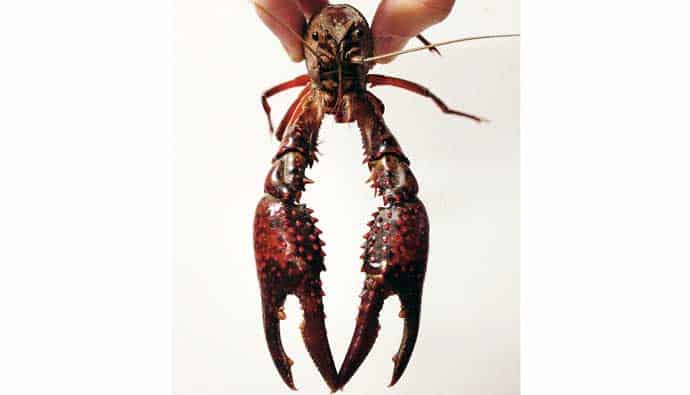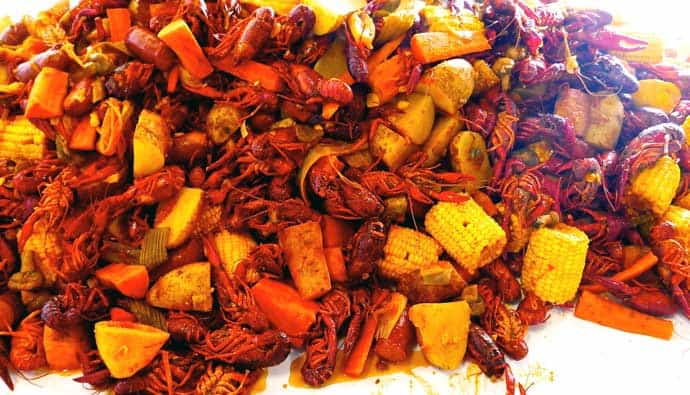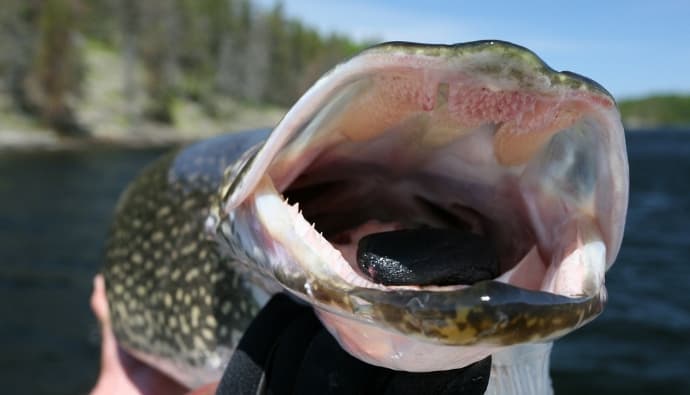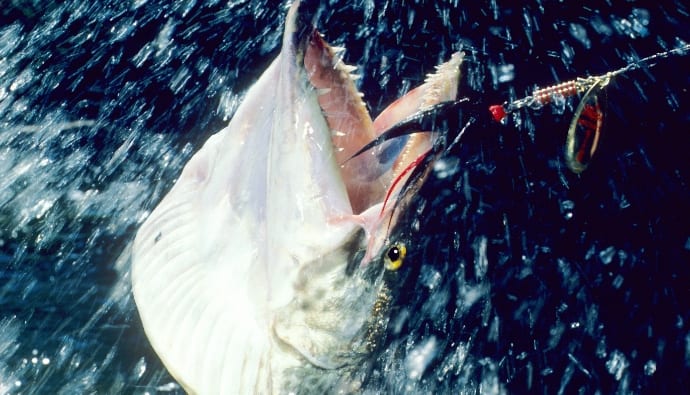Do you want to learn how to catch crawfish to make your own boil?
These freshwater lobsters can also be used as bait to catch smallmouth bass and other aggressive fish. In this guide, you’ll learn all you need to know about catching crawfish using traps and how it differs from crayfish.

Recommended Crawfish Gear:
- Frabill Crawfish Trap
- Bucket + Airstone
- Dip Net
Listen to more fishing tips on the Cast & Spear Podcast
Overview
It’s no coincidence that crawfish appear like miniature lobsters because they both are crustaceans.
Together, the head and thorax from the torso and a body that is segmented by grooves of overlapping shells.
In most cases, it is a dark brown to black color.
The eyes are mounted on flexible stalks that allow them to see in any direction. The Exoskeleton is tiny but quite strong, with five pairs of legs and sharp pincers for grasping and biting food.
Also known as yabbies, freshwater lobsters, and crawdads, they are omnivore leafy plants, fish eggs, and small insects that are the primary diets of crustaceans.
However, they are known for consuming their own, cannibalizing smaller or weaker crustaceans. They are often targeted by predators such as raccoons, snakes, and of course, humans who trap them in large numbers for crawfish boils.
Crawfish Facts
| Scientific Name | Cambarus sp. |
| Common Name(s) | Crayfish, crawdad, yabbies, freshwater lobster |
| Identifying Characteristics | Powerful claws. Resembles a small Maine lobster. |
| Habitat | Rivers and streams around rocks, mud, and vegetation. |
| Limits | Check your local regulations |
Where Do Crawfish Live?
Crawfish live in fast-flowing rivers and streams amidst rocks, mud, vegetation, and other underwater foliage they can hide or find cover in.
It prefers fast-flowing water because it cannot live long in a polluted habitat. This small crustacean is not a strong swimmer and has to wait for its food to sink to the bottom before it can eat it.
The largest gathering of crawfish usually occurs in southeastern North America, which makes up 330 species but all of them belong to the same family, i.e., Cabaridae. Many can be found in lowlands, where the water is rich in oxygen and calcium.
Crayfish Trapping

Do you want to know how to catch crayfish in a river and make sure you have enough for a fantastic boil? First, you need to know what they prefer as bait and the kind of trap that can work on them.
What is the Best Bait For Freshwater Crayfish?
Catching crawdad or crayfish is not difficult once you get the hang of making crawfish traps, but it pays to know the kind of bait that can lure this crustacean into them.
The best bait for crawfish is fish such as shiners, herring, sunfish, pogies, and gizzard shad. Some fishermen prefer to use cut-up salmon fish heads and other oily fish they can get their hands on. You can get these from the locals easily enough or make them yourself.
While fish can make for irresistible crawdad bait, that doesn’t mean you cannot experiment with more types of crawfish bait and meat.
Remember, crawfish are omnivores. Pretty much anything can work as long as it is edible, so you can also attract them using cheap cuts of chicken wings, raw chicken legs, and chicken necks.
You can also use cat food.
Whichever bait you use while you are catching crayfish, just make sure that it is fresh otherwise, you will return with an empty trap. The more fresh bait you use, the more crawfish you can trap.

Commercial Baits
If you don’t want to get your hands dirty, you can always go with formulated bait for catching crawfish.
For example, some brands, such as Purina, make this bait on a commercial scale for crawfish enthusiasts who want to catch a bucket full of crustaceans without the mess. It is particularly useful during summer when live bait can spoil faster than it can be used.
However, this kind of bait will be of no use to you when the temperature of the water drops to 70F. Use fish bait instead during this time, and it won’t go bad in the cold weather, even though your hands may get a bit smelly.
How to Catch Crawfish in a River
Crawfishing in a river or any freshwater source is not difficult if you are patient and have the right gear. If you are using bait to catch crawfish, you can use a simple but strong string to reel in this crustacean.
All you need to do is attach the bait (cat food, raw chicken leg, or fish) you have to the string using a hook or a pin.
Lower this setup into the water and move it around a bit, and when you feel a pull on the line, don’t pull in the crawfish immediately. Move the string with the bait and crawfish attached to it slowly toward shore, and then place the crawfish in the bucket.
Besides a string and bucket, you can also use a fishnet that has a long handle to catch several crawfish at the same time when you reel in.
That way, you prevent the crawfish from releasing the bait and escaping into the mud, and catching a lot at the same time.
How to Make a Freshwater Crayfish/ Crawdad Trap
While the string method is efficient, it can do a number on your back, and you will have to spend hours on the water to catch enough crawfish for a boil.
So how can you catch a lot of crawfish with little to no effort? Use a simple crayfish trap.
Crayfish Trap Instructions:
- Rinse out two plastic soda bottles (2 liters each) and remove the labels. This is important to ensure no pollutants find their way into the river or creeks you want to catch crawfish in.
- Use a box cutter to cut one bottle in half along its circumference about an inch above the middle point as cleanly as possible. The edges should be smooth.
- Cut the second bottle at a point that is a little higher than where you cut the first bottle, and make sure its edges are clean as well.
- Place the smaller cut-out bottle in the bigger one mouth first so you will have a funnel where the crawdads can crawl into. Make sure to unscrew the cap of the smaller bottle first. This way, the crawdads will be able to get into the bigger bottle but will not be able to get out.
- Now you have to attach the bottles. Drill five holes along the bottom, making sure that they are aligned, and the bottles don’t slip. Drill five more holes a centimeter above these holes.
- Zip-tie the bottles together by running a tie through the lower holes and then threading it through the one on top of it before tightening it. Repeat on the remaining holes till all of them are tied. Make sure they are tied tight enough that there are no gaps between the bottles that mud or other debris can get into.
Launching Your Crawfish Traps
- Attach a weight to the bottom of the crawfish trap to ensure that it sinks to the bottom of the creek. Do this by making a hole through the bottom of the trap and then tying a weight on it using a zip tie. A 1 to 5-pound weight should suffice.
- You will also need to add weight to the top of the trap to keep it balanced in the water. Use the same weight size that you used on the bottom and tie it to the top part of the bottle.
- Congratulations! Your crawfish trap is complete! Now you only need to bait it to make your crawfishing expedition a success. To add bait, unscrew the cap of the trap and drop the bait into it. Most people use fish meat but you can use other kinds of meat as well.

How to Catch Crawfish With Crawfish Traps
- Now you are ready to use the trap to catch crawdads. Crawfish trapping is not going to be difficult if the trap is made well and is not loose. The first thing you need to do is to tie a thin rope right under the lid of the bottle. This will prevent the trap from floating away as the crawfish start to file in.
- Use the thin rope to tie the baited trap on a tree or anything sturdy that can hold it in place and then toss it in the water. Make sure that it sinks to the bottom.
- Leave the trap in the water overnight and don’t disturb it before that or cover it with anything. Crayfish are more active at night. Plus, you may scare the crawfish away if you disturb the trap. If you try catching the crustacean in the morning, chances are you will return home with only a few empty boxes.
And that’s it! Technically, the crayfish should be attracted by the bait in the trap and should crawl into it through the small opening of the second bottle. Once they have their fill of the bait, the crayfish will not be able to get through the small hole and will be caught.
Prevent Dead Crayfish
The crayfish can only eat the bait for a short time before they begin to die. The crayfish you catch will die if you leave it in the water for any longer than a day. As the oxygen level declines, crustaceans caught in the trap inch closer to their demise.
Eventually, the lack of food bar bait and depleted oxygen will kill all crawfish in the trap.
Check how crawdads you caught by pulling the setup out of the water the next day. If it is heavier than it was before, it may be full of crayfish. Empty the setup by unscrewing the lid and then pouring your catch into boxes or a net.
Crawfish vs. Crayfish
So what’s the difference between crawfish, crawdads, and crayfish? The answer is none!
These names are synonymous and used interchangeably. The major difference is the geographic location and the dialect of the locals who catch these crustaceans.
Frequently Asked Questions
Crayfish can be found in freshwater sources such as a lake, river, and pond that has the sufficient cover it can hide in. Look for them under rocks and around underwater vegetation.
Yes, if you plan on catching a few only. Just make sure that you steer clear of their sharp claws. That pinch can be nasty! To make sure your hands remain safe, grab the crayfish behind the pincers.
Place enough water in the bucket that it covers the crustaceans when they stand on all 10 legs and no more. They can drown otherwise.





 Facebook
Facebook YouTube
YouTube








